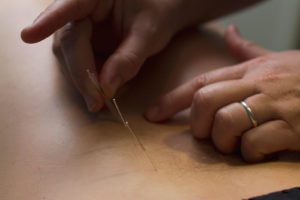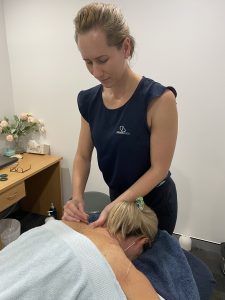Dry needling is becoming a more accepted and common treatment. It can be great at fixing problems that just won’t shift. Whether you’ve had this form of treatment before or are interested in finding out how you could benefit from dry needling, the following blog will answer all the questions you’re dying to know.

So what is Dry Needling?
Dry needling is a technique used to alleviate muscular pain by inserting an acupuncture needling into trigger points in a tight band of muscle. Active trigger points in muscles can cause pain, weakness, range restriction and can refer pain to other parts within the body. Dry needling works well to release tension within the muscle before massage and prolong the results of a normal massage treatment.
How does Dry Needling differ from Acupuncture?
The primary difference between the two treatments is that acupuncture treats for the purpose of altering flow, (Qi), or energy along traditional Chinese meridians. While dry needling follows evidence-based guidelines, recommended trigger point locations and is specific to treating muscular pain.
What does dry needling do?
Muscles need nutrients such as calcium and magnesium to contract and relax. Inserting the needle into this point will create micro traumas to the area and then bring nutrients to the area setting off the body natural healing process.
When a needle is inserted into the trigger point, it can make it spasm as this can be the nerve trigger which makes the muscle contract and relax.
The twisting of the needles once inserted into the taught band will stretch or release the muscle and fascia as it wraps around the needle.
Does it hurt?
Generally dry needling doesn’t hurt, often you will just feel pressure deep in the tissue. When the needle hits the trigger point in a muscle you can feel a twitch or spasm. This feeling is more of a surprise rather than being painful. Other sensations you can feel include referral pain and this affects people in different ways. Some people may be sore for a couple of days afterwards and others will feel no pain at all. Some body parts are also more likely to be painful such as the calves. Stretching afterwards can greatly reduce any pain felt. It can be thought of like exercise soreness or DOMS.
Can I have this as part of my normal massage treatment?
Of course you can! Just let our admin team know you may be interested in adding some dry needling to your normal massage treatment.
To find out more about dry needling, CLICK HERE.

– Carissa Elliott, Remedial Massage Therapist
If you would like to make a remedial massage appointment with Carissa, call one of our friendly team on 4724 0768 or CLICK HERE to book online.
